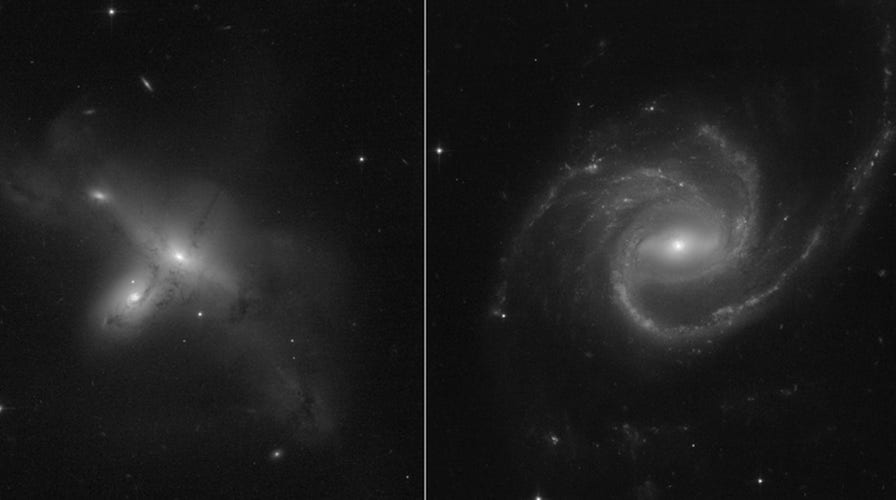NASA's Hubble spots stunning 'pinwheeling' galaxy
NASA's Hubble teleschope is sharing the wonders of the universe with its latest find, a 'pinwheeling' galaxy.
NASA's Hubble Space Telescope (HST) has delivered its first images since the telescope's payload computer suddenly halted on June 13.
The pictures show a galaxy with what the agency calls "extended spiral arms" and said in a release is the first high-resolution look at a pair of colliding galaxies.
NASA COMPLETES TESTS TO IDENTIFY PROBLEM WITH HUBBLE SPACE TELESCOPE COMPUTER
The photos were taken by a program spearheaded by the University of Washington's Julianne Dalcanton.
Other potential targets for the program included globular star clusters and aurorae on Jupiter.
Science observations restarted on July 17, after the telescope's main computer failed to receive a signal from the payload computer and subsequently placed Hubble’s science instruments into safe mode.
NASA's mission analysts, working from the Greenbelt, Maryland, Goddard Space Flight Center mission control in addition to remotely, and engineers worked together to analyze the issue and determine its cause.
The HST has been in orbit approximately 340 miles above Earth for more than 30 years. The telescope was built in the 1980s and NASA said that Hubble alumni had returned to aid in the recovery effort.
The team looked over 40-year-old paperwork, hoping to diagnose the problem quickly.

Nzinga Tull, Hubble systems anomaly response manager at NASA’s Goddard Space Flight Center in Greenbelt, Maryland, works in the control room July 15 to restore Hubble to full science operations. (Credits: NASA GSFC/Rebecca Roth)
While examining the potential of a degrading memory module, NASA switched to backup modules.
Then, the team turned on Hubble’s backup payload computer for the first time in space. Both tasks failed to resolve the issue.
Next, looking at other hardware – like the Command Unit/Science Data Formatter and the Power Control Unit – and switching to backups took 15 hours of spacecraft commanding.
LUNAR ORBIT 'WOBBLE' COULD RESULT IN HIGH-TIDE FLOODING RISE IN THE 2030S: NASA RESEARCHERS
The main computer was turned off and a "backup safe mode computer" temporarily took over the spacecraft, several boxes had to be powered for the first time and hardware needed interfaces switched,
More than 50 people worked on the switch to backup hardware, testing procedures on a high-fidelity simulator and holding a formal review of the proposed plan.
The team also analyzed data from earlier testing and identified the Power Control Unit as the potential source of their worries.

July 15, 2021 - NASA Begins Switch to Backup Spacecraft Hardware Today, NASA began a switch to backup spacecraft hardware on Hubble in response to an ongoing problem with its payload computer. (Credit: NASA/Goddard/Rebecca Roth)
Making the switch to the backup side of the Science Instrument and Command & Data Handling unit and backup Power Control Unit, NASA was successful on July 15 at 11:30 p.m. ET.
"I’m thrilled to see that Hubble has its eye back on the universe, once again capturing the kind of images that have intrigued and inspired us for decades," NASA Administrator Bill Nelson said. "This is a moment to celebrate the success of a team truly dedicated to the mission. Through their efforts, Hubble will continue its 32nd year of discovery, and we will continue to learn from the observatory’s transformational vision."
CLICK HERE FOR THE FOX NEWS APP
The HST has taken more than 1.5 million observations of the universe in its lifetime, contributing to some of the most significant discoveries of the cosmos.
Most observations missed while science operations were down will be rescheduled.





















